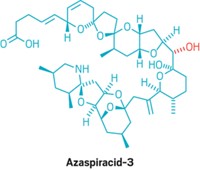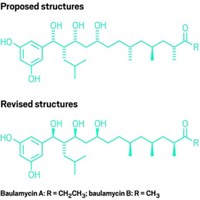Advertisement
Grab your lab coat. Let's get started
Welcome!
Welcome!
Create an account below to get 6 C&EN articles per month, receive newsletters and more - all free.
It seems this is your first time logging in online. Please enter the following information to continue.
As an ACS member you automatically get access to this site. All we need is few more details to create your reading experience.
Not you? Sign in with a different account.
Not you? Sign in with a different account.
ERROR 1
ERROR 1
ERROR 2
ERROR 2
ERROR 2
ERROR 2
ERROR 2
Password and Confirm password must match.
If you have an ACS member number, please enter it here so we can link this account to your membership. (optional)
ERROR 2
ACS values your privacy. By submitting your information, you are gaining access to C&EN and subscribing to our weekly newsletter. We use the information you provide to make your reading experience better, and we will never sell your data to third party members.
Natural Products
Lomaiviticins’ structures get a revision
MicroED helps chemists determine the correct connectivity of these complex natural products
by Bethany Halford
May 5, 2021
| A version of this story appeared in
Volume 99, Issue 17

Chemists are rethinking lomaiviticins—potent killers of cancer cells and bacteria. A new study shows that the structures of these complex natural products, which are metabolites of marine bacteria, differ from what researchers thought they were for 20 years. A team led by the University of California, Los Angeles’s Hosea M. Nelson and Yale University’s Seth B. Herzon revised the structural assignments with the help of the cryo-electron microscopy technique known as microcrystal electron diffraction (microED).
MicroED essentially gives a picture of a molecule’s skeleton. Other commonly used techniques, including nuclear magnetic resonance and mass spectrometry, can fill in details, such as where heteroatoms are located. “This is a tool that can help you solve molecules when there are arrangements and connectivity that can’t really be unambiguously determined using NMR,” says Nelson, who has championed the technique.
Chemists at Wyeth Pharmaceuticals and the University of Utah first determined the lomaiviticins’ structures in 2001 using NMR. But NMR doesn’t always accurately assign the structure of molecules like the lomaiviticins, in which many of the carbons aren’t attached to hydrogens. C–H bonds give clues about which atoms are connected to which, and if there aren’t enough of these bonds, chemists have to sometimes make assumptions about connectivity. Since the lomaiviticins’ discovery, no group has succeeded in synthesizing any of the compounds from scratch to confirm the original assignment. Nevertheless, no one doubted the structures proposed 20 years ago, say Nelson and Herzon.
Herzon’s group had been working with (–)-lomaiviticin C made via fermentation. At Nelson’s request, Herzon sent a sample to UCLA. MicroED analysis on just nanograms of the compound showed that its core differed from the original assignment. From that information, the chemists also revised the structures of lomaiviticins A and B (J. Am. Chem. Soc. 2021, DOI: 10.1021/jacs.1c01729).
Several groups have been pursuing the total synthesis of the lomaiviticins, and others are working to figure out how they kill cancer cells, Nelson says. All that work has been done with the wrong structures in mind.
“This has really opened my eyes to microED,” Herzon says. “I think it does have potential to have a transformative effect on the way that natural products are discovered and characterized.”
The structural revision of the lomaiviticins represents “game changing opportunities for both structure elucidation and total synthesis,” says K. C. Nicolaou, a natural products synthesis expert at Rice University, in an email. “The total synthesis of these molecules can now be pursued with motivation and confidence.”
Jon Clardy, who studies natural products at Harvard Medical School, says in an email that in addition to the revision, “the paper makes two other important points: defining structures of complex organic molecules with low hydrogen to carbon ratios is fraught with pitfalls, and microED, which has revolutionized structural biology, will soon do the same for small molecule structure determination.”
Nelson says he hopes the work will convince more organic chemists to use microED. “People need to give it a shot and start applying it to some of their research problems,” he says.





Join the conversation
Contact the reporter
Submit a Letter to the Editor for publication
Engage with us on Twitter